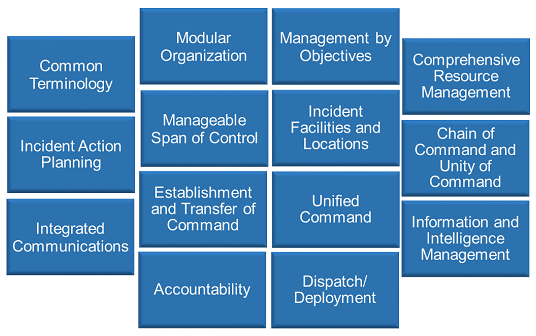How Many NIMS Management Characteristics Are There? A Comprehensive Guide
In the realm of emergency management, the National Incident Management System (NIMS) stands as a cornerstone framework for effective response and coordination during crises. At the heart of NIMS lie its management characteristics, which serve as guiding principles for agencies and organizations. In this comprehensive guide, we delve into NIMS management characteristics, and their historical evolution, and answer a pivotal question: How many NIMS management characteristics are there?
Understanding NIMS Management Characteristics
NIMS management characteristics are the bedrock upon which emergency management strategies are built. They provide a systematic approach to handling incidents, ensuring a coordinated and efficient response. In this section, we unravel the concept of NIMS management characteristics, elucidating their crucial role in the incident management landscape.

Historical Overview of NIMS
Before we delve into the specifics of NIMS management characteristics, it’s essential to grasp the historical context. NIMS didn’t materialize overnight; it’s the product of years of development, lessons learned, and a commitment to standardized emergency response. Let’s journey through the historical evolution of NIMS, understanding its roots and the driving forces behind its creation.
NIMS Management Characteristics Explained
Now, let’s dive into the heart of the matter – the NIMS management characteristics themselves. These characteristics are the fundamental building blocks of effective incident management. Understanding each one is essential for anyone involved in emergency response and preparedness.
NIMS outlines a set of five core management characteristics, which are:
1. **Common Terminology: In the fast-paced environment of emergency response, clear and uniform communication is paramount. This characteristic emphasizes the importance of using common language and terminology across all agencies and disciplines. It ensures that everyone involved understands each other, reducing confusion and streamlining coordination.
2. **Unified Command: When multiple agencies or organizations respond to an incident, a unified command structure is vital. It enables coordinated decision-making and ensures that all parties work together seamlessly. This characteristic outlines the structure and responsibilities of unified command, facilitating a unified front in crises.
3. **Manageable Span of Control: Effective leadership is crucial during emergencies. The “manageable span of control” principle ensures that supervisors can effectively oversee their teams. It specifies the ideal number of subordinates a supervisor can manage efficiently, preventing overwhelm and maintaining control.
The Evolution of NIMS Characteristics
Understanding the historical context of NIMS management characteristics is essential to appreciate their evolution. NIMS didn’t emerge fully formed but evolved to adapt to changing needs and lessons learned from past incidents.
NIMS, as we know it today, traces its roots back to the 1970s and 1980s when various incidents exposed the shortcomings of fragmented emergency management approaches. Over the years, it underwent significant development and refinement.
In particular, the 9/11 attacks and Hurricane Katrina in 2005 were pivotal moments that prompted a reevaluation of emergency management in the United States. The need for a standardized, integrated, and flexible approach became evident.
This evolution led to the current set of NIMS management characteristics, which have been continually updated to address emerging challenges, including cyber threats, pandemics, and natural disasters.
How Many NIMS Management Characteristics Are There?
The central question of this article revolves around the number of NIMS management characteristics. It’s a question that often arises when individuals delve into the world of emergency management.
The answer is concise: NIMS outlines five core management characteristics, as mentioned earlier. These characteristics encapsulate the principles and practices that underpin effective incident management. While other components and supporting elements exist within NIMS, these five characteristics are the cornerstone.
Understanding the quantity and significance of these characteristics is pivotal for anyone involved in emergency response, preparedness, or planning. They serve as a blueprint for effective and coordinated incident management.
Implementing NIMS Management Characteristics
Understanding the theoretical aspects of NIMS management characteristics is only part of the equation. The real value lies in their practical application. In this section, we’ll explore how these characteristics are put into action in the field of emergency management.
- Common Terminology in Action: Picture a multi-agency response to a wildfire incident. Firefighters, law enforcement, and emergency medical personnel from various jurisdictions converge at the scene. Thanks to the common terminology characteristic, they all use the same language to describe the incident, share critical information, and coordinate their efforts seamlessly. This clarity enhances their ability to work together effectively.
- Unified Command in Practice: Imagine a hurricane approaching a coastal region. Multiple agencies, including local government, the National Guard, and federal disaster response teams, are involved. The unified command is established, ensuring that each agency’s leaders work together to make decisions that benefit the entire community. This collaborative approach minimizes confusion and maximizes the utilization of resources.
- Manageable Span of Control in Real-Life Situations: During a large-scale public event, the event’s safety and security team is responsible for maintaining order and responding to incidents. To ensure effective leadership, the principle of a manageable span of control is applied. Supervisors oversee a reasonable number of security personnel, allowing for better communication, supervision, and decision-making.
Benefits of NIMS Management Characteristics
Now that we’ve explored the theoretical and practical aspects of NIMS management characteristics, it’s crucial to understand why they matter. Each of these characteristics offers tangible benefits to emergency responders, agencies, and the communities they serve.
- Enhanced Communication: Common terminology fosters clear and effective communication, reducing misunderstandings and errors during critical moments.
- Coordinated Response: Unified command ensures that various agencies work together seamlessly, preventing duplication of efforts and streamlining the response.
- Efficient Leadership: A manageable span of control allows leaders to maintain control and make informed decisions, even in high-stress situations.
Challenges and Critiques
While NIMS management characteristics are undeniably valuable, it’s essential to acknowledge that no system is without its challenges and critiques. In this section, we’ll explore some of the common issues and debates surrounding these characteristics.
- Complexity vs. Simplicity: Some critics argue that NIMS, with its detailed management characteristics, can be overly complex. They suggest that simplifying the system could make it more accessible and user-friendly, especially for smaller agencies and organizations.
- Resistance to Change: Implementing NIMS management characteristics may face resistance from agencies accustomed to their procedures. Adapting to a unified system can be challenging, requiring training and a cultural shift.
- Resource Constraints: Smaller jurisdictions or agencies with limited resources may struggle to fully implement NIMS, which can demand additional personnel, training, and equipment.
- Flexibility vs. Rigidity: While NIMS offers a standardized framework, some argue that it might be too rigid to accommodate the unique needs of certain incidents or regions. Balancing flexibility with standardization remains an ongoing debate.
By acknowledging these challenges and critiques, emergency management professionals can work towards refining and improving the NIMS system. It’s essential to maintain a balance between standardization and adaptability to ensure its continued effectiveness.
Conclusion
In this comprehensive exploration of NIMS management characteristics, we’ve unveiled the core principles that underpin effective incident management. From common terminology to unified command and a manageable span of control, these characteristics provide a roadmap for coordinated and efficient emergency response.
We’ve answered a pivotal question: How many NIMS management characteristics are there? NIMS outlines five key characteristics that serve as the foundation for effective incident management.
As we conclude this guide, it’s crucial to recognize that NIMS management characteristics are not merely theoretical constructs; they are practical tools that save lives, protect communities, and minimize the impact of disasters. By understanding, embracing, and continually refining these principles, emergency management professionals and agencies can better serve the public and navigate the complexities of crises.
Frequently Asked Questions (FAQs) – NIMS Management Characteristics
Q: What is NIMS, and why is it important in emergency management?
A: NIMS, the National Incident Management System, is a framework for effective incident management in the United States. It’s crucial because it provides a standardized approach to emergency response, enhancing coordination among agencies and organizations.
Q: How do NIMS management characteristics benefit emergency responders?
A: NIMS management characteristics offer clear communication, unified decision-making, and efficient leadership, ensuring a more organized and effective response to incidents.
Q: What are the five core NIMS management characteristics?
A: The five core characteristics are Common Terminology, Unified Command, Manageable Span of Control, Incident Action Planning, and Resource Management.
Q: Are NIMS management characteristics only applicable to large-scale incidents?
A: No, NIMS management characteristics are adaptable to incidents of all sizes. They provide a scalable framework that works for everything from local emergencies to national disasters.
Q: How can agencies implement NIMS management characteristics effectively?
A: Effective implementation involves training, coordination, and incorporating the characteristics into agency policies and procedures.
Q: Can NIMS management characteristics be used internationally?
A: While NIMS is a U.S. framework, its principles of effective incident management can serve as a model for international emergency response efforts.
Q: Are there critiques of the NIMS management characteristics system?
A: Yes, some critics argue that NIMS can be overly complex and rigid. However, ongoing efforts aim to address these concerns while maintaining the system’s effectiveness.
Q: What is the role of NIMS management characteristics in disaster preparedness?
A: NIMS characteristics are a vital component of disaster preparedness, helping agencies plan and coordinate their response in advance of potential incidents.
Q: Are there resources available for further training on NIMS management characteristics?
A: Yes, numerous training programs and resources are available to help emergency responders and agencies understand and implement NIMS management characteristics.
Q: How can I stay updated on any changes or updates to NIMS management characteristics?
A: You can stay informed by regularly checking official sources such as FEMA (Federal Emergency Management Agency) and attending NIMS-related training and workshops.
Remember that NIMS management characteristics play a pivotal role in emergency management and can benefit both seasoned professionals and those new to the field.




